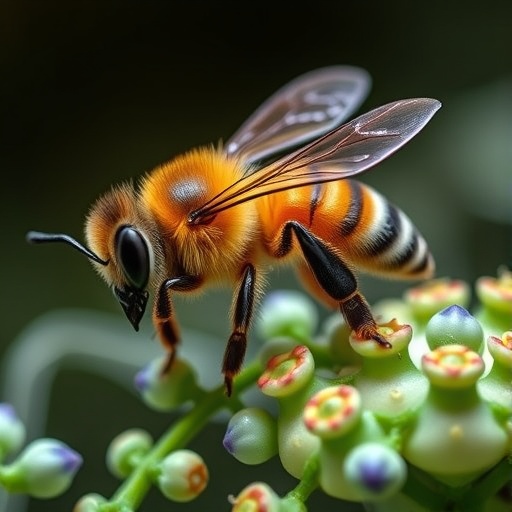In a groundbreaking study published in BMC Genomics, a team of researchers led by Hannah L. Cook has unveiled remarkable insights into the genetic intricacies of bees by analyzing the transposable elements across 75 distinct bee genomes. This work not only broadens our understanding of bee biodiversity but also highlights the evolutionary pressures shaping their genomes. Transposable elements, often referred to as “jumping genes,” have been underexplored in the context of hymenopteran evolution, making this comparative analysis particularly significant.
The research employed advanced genomic techniques to catalogue and compare the diversity of transposable elements within the sampled genomes. The methodology centered around high-throughput sequencing and bioinformatic analyses to precisely characterize these elements across various bee species. This allowed the team to identify both the commonalities and differences in transposable element content, providing a clearer picture of how these genomic components contribute to bee evolution.
One of the key findings of the study was the pervasive nature of transposable elements within the genomes of bees. The analysis showed that these elements are not only abundant but also exhibit considerable variability among different species. This variability could indicate a historical response to environmental pressures or adaptive strategies that various bee species have developed over millennia. The researchers hypothesize that transposable elements may play a crucial role in gene regulation, influencing traits such as foraging behavior and resilience to disease.
Moreover, the research team meticulously classified the different types of transposable elements found within the genomes. These include both Class I elements, which replicate through an RNA intermediate, and Class II elements, which move directly as DNA. Understanding the distribution and type of these elements can inform on how bees adapt to changing environments, as well as their evolutionary trajectories. This adequate representation of transposable elements is vital for comprehending the dynamic nature of the genome in response to evolutionary pressures.
Importantly, Cook et al. also investigated the functional implications of transposable elements within the bee genomes. This aspect of the study underscored the potential for these elements to drive phenotypic diversity within populations. For instance, the researchers suggest that specific transposable elements could influence traits related to social behavior, reproductive strategies, and environmental adaptations. Such insights can be pivotal for conservation efforts, especially in the face of declining bee populations worldwide.
The comparative approach adopted in this study is novel, as it synthesizes data from a wide range of bee species, each with unique ecological niches and evolutionary histories. This represents a significant advancement in the field of evolutionary genomics, demonstrating that a broader understanding of a group’s genetic diversity is attainable through collaborative research. The research opens avenues for future studies to explore the evolutionary roles transposable elements may have played across other taxa.
The implications of this research extend beyond bees to broader ecological contexts. The findings challenge previously held views about the static nature of genomes and showcase the importance of genomic plasticity. By illustrating how bees exhibit significant genomic variability through transposable elements, the study raises intriguing questions about the fine balance of stability and change within species. This balance is critical, particularly in the context of rapid climate change and habitat loss, which poses substantial risks to bee populations.
Furthermore, as scientists continue to uncover the relationships between genetic components and ecological resilience, the implications of these findings are likely to resonate within the fields of agriculture, pollination ecology, and conservation biology. The insights into how transposable elements facilitate adaptability and evolution may inform strategies to protect pollinators, which are vital for global food production.
In the wake of this study, the call for more comprehensive genetic research into pollinator health is more pressing than ever. The integration of genomic data with ecological observations can yield a powerful toolkit for addressing the many challenges faced by bee populations. Future studies that build upon Cook et al.’s work could incorporate longitudinal approaches to monitor how transposable element diversity might change in response to environmental shifts.
This research has indeed paved the way for a more intricate understanding of the genetic architecture of bees. By linking transposable elements to evolutionary outcomes, Cook and colleagues have provided a framework that invites further investigation into the genetic basis of traits that are critical for the survival of bee species. As more species are analyzed, the insights could contribute meaningfully to safeguarding pollinator diversity and, by extension, the ecosystems that depend on them.
As ecological and environmental conditions continue to evolve, addressing the need for robust frameworks to study genetic diversity becomes paramount. In studying the evolution of transposable elements, researchers can glean insights that have broad implications, offering a key to unlocking genetic mysteries that have long eluded scientists. This remarkable study sets a new benchmark in understanding the complex interplay between genetics and evolution in one of nature’s most vital groups of insects.
In conclusion, the comprehensive analysis of transposable elements across bee genomes by Cook, Sproul, Murray, and their team serves as a crucial reminder of the intricate relationships present within and among species. Highlighting the role of genomics in evolutionary studies, this research opens up possibilities for future explorations in biodiversity and adaptation. The dialogue between genome structure and ecological function is just beginning, and it is only through such meticulous studies that we will truly understand the complexities of life and evolution on our planet.
Subject of Research: Transposable element diversity and evolution in bee genomes
Article Title: A comparative analysis of transposable element diversity and evolution across 75 bee genomes
Article References:
Cook, H.L., Sproul, J.S., Murray, E.A. et al. A comparative analysis of transposable element diversity and evolution across 75 bee genomes. BMC Genomics 26, 1000 (2025). https://doi.org/10.1186/s12864-025-12190-9
Image Credits: AI Generated
DOI: https://doi.org/10.1186/s12864-025-12190-9
Keywords: Transposable elements, bee genomes, evolution, biodiversity, genomic diversity, gene regulation, ecological resilience, conservation biology.




